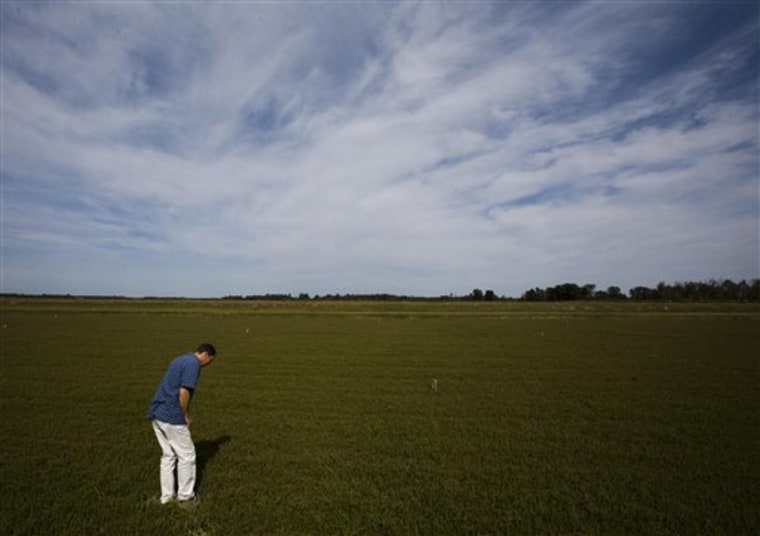Until this fall, workers at Nodji Van Wychen's cranberry farm sorted fruit with the same wooden technology used by her grandfather.
Firm berries bounced through the mills' seven wooden slats before 15 workers scrutinized them for color and imperfections. Today, that system have been replaced by $500,000 worth of computerized scanners that need only one or two people to do a final visual check before the berries are bagged.
Wisconsin already produces nearly 60 percent of the nation's cranberries, but with food companies calling for more fruit to meet growing worldwide demand, farmers here are making improvements in nearly all aspects of their operations to increase their efficiency and harvest.
The common goal is expanding Wisconsin's dominance in an industry where it is already No. 1. Failure could mean the loss of millions of dollars of business to eastern Canadian provinces eagerly building their cranberry industry.
Some Wisconsin growers are renovating marshes and developing heartier hybrids that produce more berries. Others, such as Van Wychen, are investing in high-tech equipment to more quickly harvest, sort and package fruit.
She and her husband, Jim, both 60, said their new equipment will help them keep their farm outside Warrens in western Wisconsin going for future generations.
They were already having difficulty finding seasonal workers to sort their cranberries when they decided to invest in three scanners that use touch pads, ultraviolet light and lasers to check the fruit for firmness, color and small dents and imperfections.
The couple spent $250,000 automating their packaging room before they began buying the scanners four years ago. This year, they became the first fresh cranberry growers to install a vacuum tubing system to quickly and cleanly move their fruit from the warehouse cooler to the sorting room.
By adapting equipment already used by other types of farmers, the Van Wychens can sort and package about 10,000 pounds of fruit per hour.
While the Van Wychens invested in efficiency, the Grygleski family a dozen miles down the road in Tomah is focused on increasing production with the development of new cranberry vines.
Ed Grygleski Sr., 69, began breeding cranberry vines to create new hybrids in the 1970s and developed one, called GH1, used by growers in Wisconsin and along the eastern seaboard from Canada to New Jersey. A successful hybrid needs a strong red color, good sugar content, large berry and resistance to disease and injury, he said.
But mostly, he and his family are looking to increase their plants' yield, said his son, Ed Grygleski, Jr., 39. A GH1 cranberry vine generally produces 350 to 400 barrels per acre, on average about 30 barrels more than the Stevens cranberry, which has been the industry standard, he said.
A newer hybrid the family is testing and could release in the next few years has been averaging 600 barrels per acre, said Ed Grygleski, Jr. That means it has the potential to greatly increase growers' production in a time of high demand.
"The cranberry industry is in a large growth cycle right now," Ed Grygleski Jr. said. "A lot of growers are planting new varieties and looking at the highest yielding varieties which are available."
Ocean Spray Cranberries Inc., which dominates the cranberry industry, has encouraged other Wisconsin growers to innovate, hoping to see more fruit grown close to plants it has here. Just last week, it opened an expansion in its now 440,000-square-foot plant in Wisconsin Rapids to provide Craisins to food companies that make trail mix, muffins and other products.
Wisconsin has about 18,000 acres planted in cranberries, and the harvest that started Monday is expected to be its second-largest on record with 3.85 million barrels, according to the National Agricultural Statistics Service.
Nationally, cranberry growers are expected to harvest nearly 6.9 million barrels this year, but that's not nearly enough to meet the worldwide demand for juice and sweetened dried cranberries, Ocean Spray CEO Randy Papadellis said.
Wisconsin farmers say expansion is difficult because most of their property is wetlands, requiring them to get permits from the U.S. Army Corps of Engineers and state Department of Natural Resources, which are reluctant to see the environmentally sensitive areas disturbed.
Industry representatives have been talking to the two agencies about ways to speed up the permit process while still addressing environmental concerns, and DNR deputy water division administrator Bruce Baker said a new streamlined procedure should be in place within a month.
